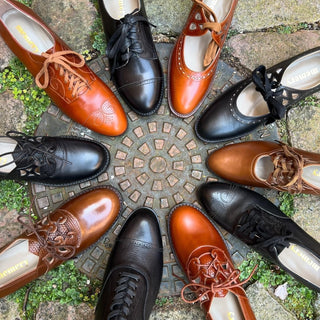Edwardian Era and Art Nouveau
The early 1900s and 1910s are often referred to as the Edwardian era, named after British King Edward VII, or as the Art Nouveau period, influenced by French culture and design. Fashion underwent significant changes during this time, transitioning away from the elaborate styles of the Victorian era. These shifts were partly influenced by World War I (1914–1918), which had a profound impact on society and clothing trends.
Explore our collection of Edwardian shoes and boots, along with other footwear from the 1900s to the 1920s.

A classic Edwardian ensemble featuring a nipped-in waist, a long flowing skirt, and a parasol to provide shade from the sun. Our Edwardian boots, the Victoria boots in black, complimented the outfit. From our historical fashion show in May. Photo: Tami Meijburg
From the Edwardian S-Curve to the Fluid Empire Waist
In the 1900s and 1910s, societal changes—such as women moving into traditionally male roles, gaining the right to vote, attending universities, and taking over men’s jobs during the First World War—necessitated more practical clothing for women. Simpler designs, shorter skirts (often mid-calf length for easier movement), and looser dresses that placed less emphasis on an hourglass figure became prevalent.
At the start of the century, the Edwardian S-curve silhouette was the height of fashion. Corsets were designed to push the chest forward, creating a wasp-like waist. However, by the 1910s, this silhouette had started to fade in popularity. Empire-waist dresses—featuring a high waist just below the bust and flowing skirts—offered a more relaxed and fluid look. Large, elaborate hats adorned with feathers, flowers, or ribbons were fashionable, alongside gloves, parasols, and jewellery, which were essential accessories for women of all classes.
Fashion for Working-Class Women in the 1900s
For working-class women, practicality and durability were key. Clothes needed to endure long hours of physical labour, whether in factories or on farms. Dresses were often made from sturdy fabrics like cotton or wool, featuring high collars and long sleeves. Skirts were generally long and full, though some were slightly shorter for practicality. Aprons were worn over dresses to protect them during work, and sturdy boots or shoes were a necessity. Simple hats or headscarves completed their everyday attire.
Fashion for Upper-Class Women in the 1900s
Among upper-class women, the iconic Edwardian S-silhouette dominated fashion. Corseted waists paired with voluminous skirts, supported by petticoats, were defining features. Bodices were frequently decorated with lace, embroidery, and luxurious fabrics like silk or satin. High-necked blouses and long sleeves reflected the modest ideals of the time.
For formal events, women wore opulent evening gowns crafted from materials such as velvet, silk, and satin, often embellished with beads or sequins. Accessories like large hats, gloves, and jewellery—such as pearls and diamonds—completed the look.

An example of a late 1910s to early 1920s outfit, characterised by a looser silhouette and a simpler cut, reflecting the shift towards more practical and relaxed fashion of the time. This look was featured in my historical fashion show back in May. Photo: Tami Meijburg
Shoes: From French Heels to Practical Mary Janes and Oxfords
Women’s Edwardian footwear was often made of leather, with the curved “French heel” being especially popular, which is also what our Rose boots are inspired by. Practicality led to the adoption of lower block heels on boots and shoes. High lace-up or buttoned boots were common, while Mary Jane and Oxford shoes gained popularity in the late 1910s.

Our Ruth Boots are a classic Edwardian-style lace-up boot with a low, practical heel.
Men’s Fashion in the Early 1900s
Men’s fashion evolved more gradually than women’s during the 1900s and 1910s. A typical outfit consisted of a three-piece suit: trousers, a jacket, and a waistcoat. Waistcoats were high-cut, and suits were slim-fitting, with high-waisted trousers that narrowed at the ankles.
When World War I began, military influences permeated men’s fashion. Structured cuts, simple colours like khaki, and practical garments such as belted coats and trench coats reflected the war’s impact.
Fashion for Working-Class Men in the 1900s
For working-class men, clothing was functional and durable. Trousers or overalls were paired with simple shirts or waistcoats. Heavy boots or sturdy shoes were essential for labour-intensive jobs, while flat caps were a popular accessory for both work and leisure. During colder months, wool or tweed coats provided warmth.
A practical feature of working-class men’s shirts was the use of detachable collars and cuffs. This allowed only the most soiled parts of the garment to be washed, preserving the rest of the shirt and reducing wear and tear. Shirts often featured thin striped patterns, typically white with blue, green, or brown stripes, which helped conceal stains.
Fashion for Upper-Class Men in the 1900s
Upper-class men adhered to formal styles, with frock coats, waistcoats, and trousers being staples. Morning coats were worn for daytime events, while tailcoats were reserved for evening occasions. Top hats were a must for formal attire. Crisp white shirts, often worn with cravats or bow ties, symbolised wealth, as they required frequent washing and could easily be replaced.
Men’s footwear included polished leather shoes, while pocket watches and cufflinks were key accessories.

American fashion plate of upper class menswear from 1896. Notice the slim, long silhouette of the shoes. Source: Metropolitan Museum of Art
Men’s Edwardian Shoes
Men’s footwear during the Edwardian period complemented the sleek styles of the time. Shoes and boots were crafted from leather, featuring pointed toes and simple yet elegant detailing. Fastened with either laces or buttons, they had snug fits. Black or brown leather boots were common among the working class.

Our William Shoes embody the Edwardian aesthetic, featuring a classic pointed toe and lace fastening.
Curious about what happened next in 20th-century fashion? Read about the iconic Gatsby era—the 1920s—in our blog post right here: 1920’s Fashion - Discover the Styles of the Roaring Twenties
Sources
- Shoes: An Illustrated Story by Rebecca Shawcross
- Tidens Mode by Anne-Grete Steckhahn
- Vintage Fashion: Collecting and Wearing Designer Classics by Emma Baxter-Wright, Karen Clarkson, Sarah Kennedy, and Kate Mulvey




